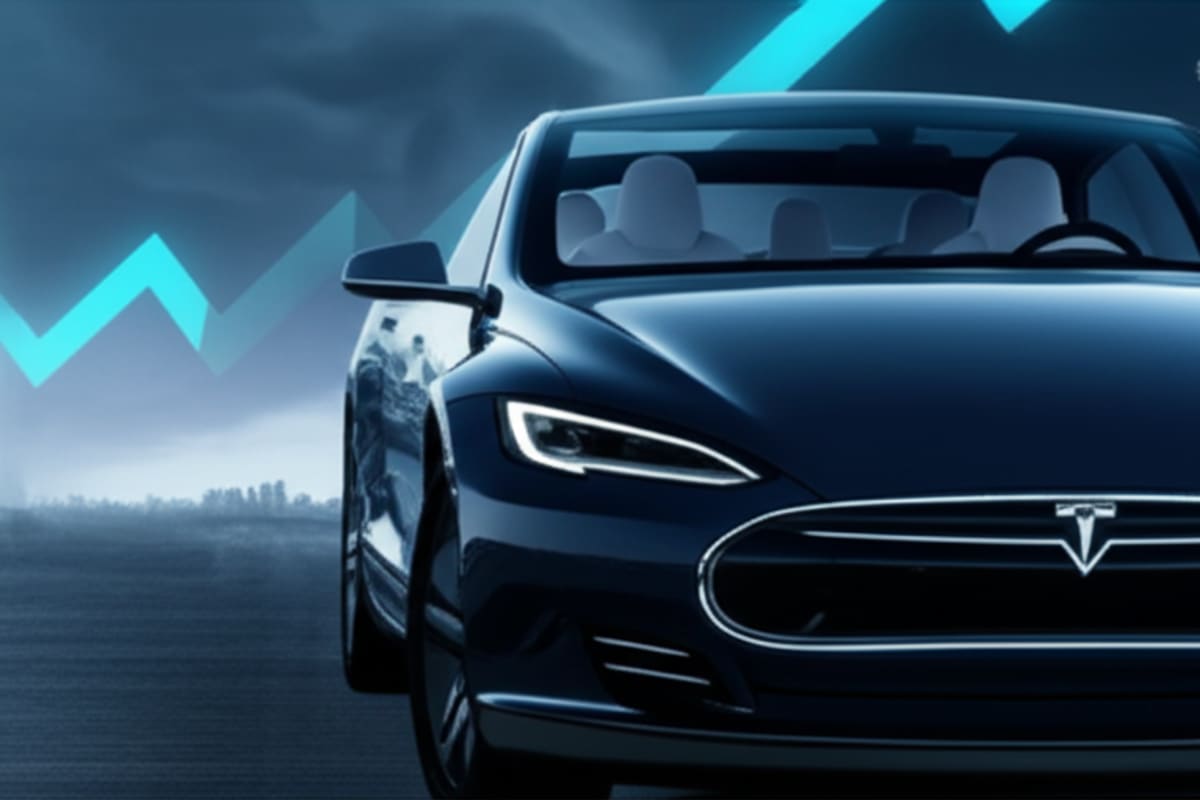Tesla's Q3 Sales Surge: A Last Hurrah Before AI Pivot & Global Headwinds?

Tesla, the electric vehicle (EV) pioneer, recently unveiled its third-quarter 2025 performance, presenting a complex picture.
Background
While a temporary sales surge, largely fueled by external factors, provided a brief respite, the company faces significant global headwinds and an ambitious, yet potentially distant, strategic pivot towards artificial intelligence (AI) and robotics
Q3 2025 Performance: A Brief Respite for Tesla
The period between July and September 2025 witnessed a noticeable uptick in Tesla's deliveries, a key metric often used as a proxy for sales in the direct-to-consumer automotive industry
This positive momentum offered a welcome contrast to the slower growth experienced earlier in the year
Tesla reported delivering a total of 497,099 vehicles, a robust 7.4 percent increase compared to the 462,890 vehicles delivered in the third quarter of 2024.
This increase was primarily fueled by strong demand for the Model 3 and Model Y, which collectively accounted for 481,166 units.
The remaining 15,933 units comprised "other vehicles," including the higher-priced Model S and Model X, as well as initial deliveries of the long-awaited Cybertruck
The $7,500 Tax Credit Influence and Inventory Reduction
However, the seemingly strong sales quarter was significantly influenced by the impending expiration of the lucrative $7,500 federal EV tax credit in the United States on September 30th
Consumers, eager to capitalize on this substantial incentive, accelerated their purchase decisions, artificially inflating demand in the short term
Analysts predicted this effect, and Tesla's Q3 numbers seem to confirm it
A key indicator of this dynamic was Tesla delivering approximately 50,000 more vehicles than it produced during the quarter.
The company produced 447,450 vehicles (435,826 Model 3/Y, 11,624 "other"), representing a 5 percent decrease compared to the 469,796 vehicles produced in Q3 2024
While this production decrease might initially seem concerning, the higher delivery numbers effectively helped Tesla reduce the significant inventory that had accumulated during the first half of 2025
This inventory reduction provided a temporary reprieve from potential overstock challenges and associated financial pressures
Global Headwinds and Intense Competition
While the US market provided a vital, albeit potentially temporary, boost, the international landscape for Tesla remains considerably challenging.
Similarly, the crucial Chinese market, a key battleground for global EV dominance, continues to present a difficult environment for Tesla
The company faces escalating competition from formidable domestic manufacturers such as BYD and Geely, which are rapidly expanding their EV offerings, often at more competitive price points and with localized features catering specifically to Chinese consumers
This intensified competition is eroding Tesla's once-dominant position in the Chinese market
Elon Musk, Tesla's CEO, has acknowledged that the company is bracing for "a few rough quarters" due to the expiring incentives and broader macroeconomic headwinds
These headwinds include rising interest rates and persistent inflationary pressures that could dampen consumer spending on big-ticket items like EVs
This admission underscores the critical insight that Tesla's Q3 2025 sales surge was somewhat of an anomaly, primarily driven by the expiring US federal EV tax credit, leading to significant inventory reduction, and masking underlying demand issues and intense global competition
Strategic Pivot to AI and Robotics: A High-Stakes Future
In response to these near-term challenges, Tesla is attempting a bold strategic pivot, with Musk placing the company's long-term prosperity squarely on ambitious AI and robotics initiatives
He firmly believes that Tesla will experience a significant rebound as its plans for robotaxis and humanoid robots come to fruition
Musk has set aggressive targets, claiming that 50 percent of the US population will have access to Tesla's robotaxis by the end of 2025, despite the service currently being limited to Austin and San Francisco and facing regulatory hurdles
This ambitious vision was further articulated in the latest version of Tesla's "Master Plan," which signals a strategic shift away from the day-to-day EV business towards a future dominated by advanced AI and robotics technologies
Musk's Pay Package and Personal Commitment
Adding to the high stakes, a proposed new pay package for Musk, if approved by shareholders on November 6th, could potentially make him the world's first trillionaire
This unprecedented compensation is contingent upon Tesla achieving a series of exceptionally ambitious milestones, including producing over a million robots, a million robotaxis, and creating a staggering $7
5 trillion in value for shareholders The scale of these goals underscores the magnitude of Tesla's strategic ambitions.
Signaling his personal commitment to this future, Musk recently bought $1 billion in Tesla stock, his first open-market purchase in over five years.
This significant investment underscores the high stakes and demonstrates his confidence in the AI-driven future of the company
Skepticism and Product Line Challenges
However, significant skepticism surrounds these futuristic ambitions.
Industry analysts and financial commentators have expressed reservations about the feasibility and timeline of Tesla's AI and robotics initiatives
Critics argue that these ambitious shifts are likely years away—if they materialize at all—leaving Tesla to contend with an aging lineup of vehicles and a potentially "battered brand image" in the current challenging environment
The company's promised cheaper version of its top-selling Model Y, slated for volume production in the second half of 2025, has yet to see any substantial updates or concrete announcements, further fueling concerns about its ability to introduce more affordable models to broaden its market appeal and compete effectively with increasingly price-competitive rivals
The delay of a cheaper Model Y, combined with an "aging lineup," highlights immediate product strategy challenges amidst intensifying global market competition
Southeast Asian Contextualization: A Mirror for Global Trends
For Southeast Asian markets, Tesla's narrative carries particular relevance.
While specific federal tax credits like those in the US are absent, many ASEAN governments are actively implementing their own EV incentives (eg.
, tax exemptions, subsidies, charging infrastructure development) to accelerate EV adoption
This means the region could experience similar "boom and bust" cycles tied to the introduction and eventual phasing out of such policies, affecting consumer behavior and overall market stability
The fierce competition Tesla faces from Chinese EV manufacturers in its home market serves as a direct precursor to what is unfolding in Southeast Asia
Brands like BYD, Chery, Wuling, and Nio are aggressively entering markets like Thailand, Indonesia, Malaysia, and Vietnam, often with models that are more competitively priced than Tesla's offerings
This presents a significant challenge for Tesla in a price-sensitive region where affordability is a major driver of purchasing decisions
The delayed launch of a cheaper Model Y is therefore a critical missed opportunity for greater market penetration in the SEA region
Furthermore, the success of robotaxis and humanoid robots, while futuristic, presents a unique set of challenges in Southeast Asia, including diverse regulatory landscapes, varying infrastructure development levels, and potentially higher labor costs that might not always make robotic solutions economically viable in the short term
However, long-term applications in logistics, smart cities, and industrial automation could still find traction if the technology proves robust and cost-effective
Conclusion: A Pivotal Juncture for Tesla
In conclusion, Tesla's Q3 2025 results offer a mixed picture characterized by short-term gains, global struggles, and a long-term vision fraught with uncertainty
The company's Q3 performance highlights the significant influence of policy incentives on consumer behavior in the EV market, potentially masking underlying demand issues and intense global competition
The challenges in Europe and China, particularly stemming from aggressive domestic manufacturers like BYD, underscore a fragmented global EV landscape
Tesla's strategic pivot to AI and robotics represents a high-risk, high-reward strategy for long-term growth amidst current market saturation and pricing pressures
For Southeast Asia, these trends are acutely relevant, with local governments offering incentives mirroring the US tax credit's impact, and Chinese EV brands aggressively penetrating the market, challenging Tesla's premium positioning
The coming quarters will be pivotal in determining whether Tesla can navigate its immediate challenges and successfully pivot towards its ambitious AI-driven future, a trajectory closely watched by global investors and particularly relevant for the evolving EV landscape in Southeast Asia
```